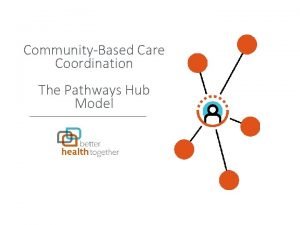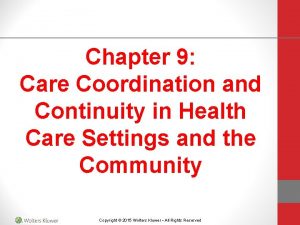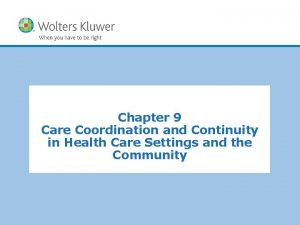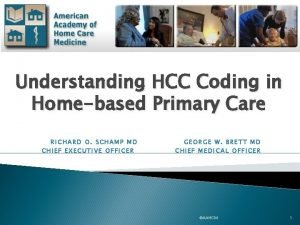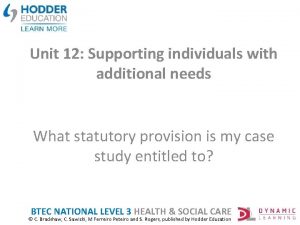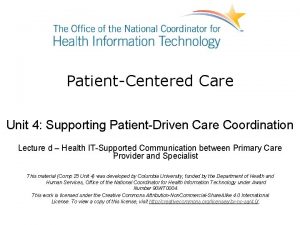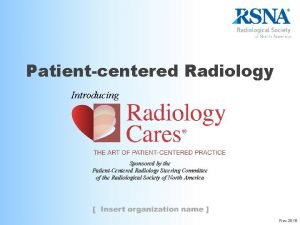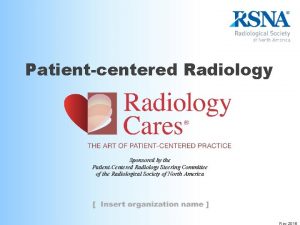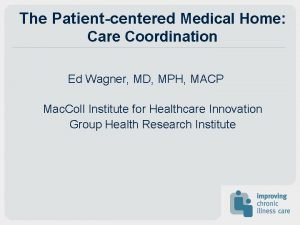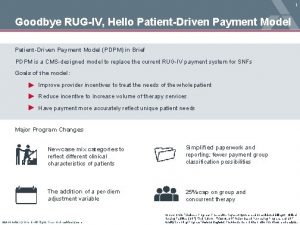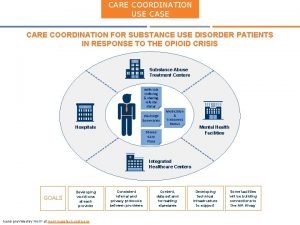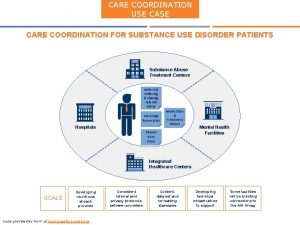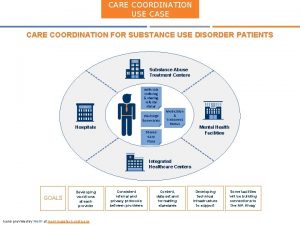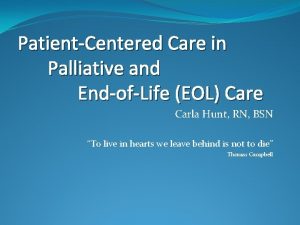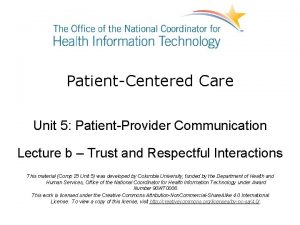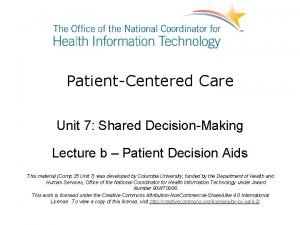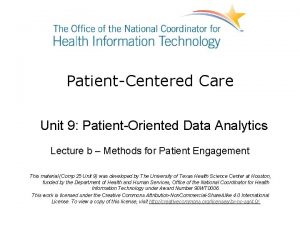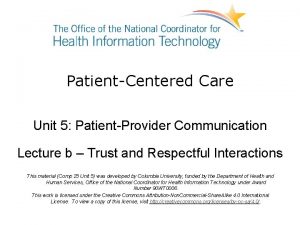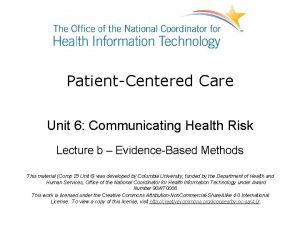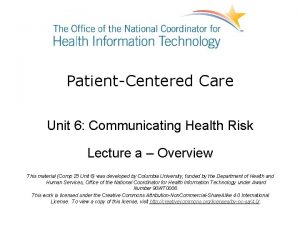PatientCentered Care Unit 4 Supporting PatientDriven Care Coordination






















- Slides: 22

Patient-Centered Care Unit 4: Supporting Patient-Driven Care Coordination Lecture a – Patient-Initiated Information Exchange This material (Comp 25 Unit 4) was developed by Columbia University, funded by the Department of Health and Human Services, Office of the National Coordinator for Health Information Technology under Award Number 90 WT 0004. This work is licensed under the Creative Commons Attribution-Non. Commercial-Share. Alike 4. 0 International License. To view a copy of this license, visit http: //creativecommons. org/licenses/by-nc-sa/4. 0/.

Supporting Patient-Driven Care Coordination Learning Objectives • Objective 1: Explain the importance of patient-driven care coordination • Objective 2: List ways a patient can use technology to drive care decisions • Objective 3: Describe the concept of patient-initiated information exchange 2

Information exchange • Patients can manage their care coordination through information exchange technology • Patients can have all of their health information in one location • Health information follows the patient as they move from provider to provider • Patients can share their health information when needed • Patients can easily track and monitor their own health • Patient can update and correct their health or billing information 3

Technology • • Blue Button i. Blue Button Personal health record (PHR) Patient portal 4

Blue Button • Developed by the U. S. Department of Veterans Affairs (VA) in coordination with CMS and the U. S. Department of Health and Human Services (HHS) • Enables patients to connect with their health plans, electronic medical record providers, and other health care providers to locate, view, and download personal health information. Blue Button logo (Source: ONC) • Find important information when needed • Make informed decisions • Share information with others • Review health record accuracy • Track scheduled health events • Mobile access 5

Blue Button challenges • A connection must be made to each separate organization where care was provided • Not all organizations have joined the Blue Button initiative • Cannot make corrections to medical record using Blue Button 6

i. Blue Button • Combines information into one record from health care providers such as Medicare, VA, insurance plans, and health records • Organizes all of these records into a summary view • Accessible on a mobile device • Health information can be viewed annotated • Links to information that allow the patient to learn more about health topics or better understand terms • Allows records to be sent directly to a care provider’s computer or i. Pad • The i. Blue button provides two applications, one for patients and one for care providers • Patient can correct their health information right on the app • The i. Blue Button must be purchased by consumers and providers 7

i. Blue Button challenges • Not all providers are participating with i. Blue Button • i. Blue Button has a cost for download and use • Use of i. Blue Button app is not widespread i. Blue Button logo (Source: ONC) 8

Personal health record (PHR) • Patient-initiated electronic record that is separate from the EHR • Contains information selected and added by the patient • Allows the patient the ability to update and change their health information at any time • Provides the patient the ability to share this information with anyone that they choose 9

PHR challenges • Patient must add health information manually • Patient must update health information manually • Limited ability for providers to send information directly to PHR 10

Patient portal • Patient access to portions of the electronic medical record managed by their health care provider • Accessed through a secure login site • Associated with one health system • Contains records from health care provided only within that system 11

Patient portal challenges • Health information for care delivered within one health care system • Each patient portal is different • Not all information may be available in the portal 12

Additional barriers • Although development and implementation of technologies designed to support patentinitiated information sharing are proceeding at a fast pace, most of these solutions do not yet provide a true seamless exchange of information • Barriers: – – Technical Social Cultural Legal 13

Technical barriers • Data standards allow for information from one system to integrate into another system • No standards creates an inability to integrate information meaningfully into other health records • Medical language needs to be updated to a patient-friendly vocabulary 14

Financial barriers • Patient cost to access and use technology • Provider cost to access and use technology • Slow public acceptance and value of PHR technology • Failed PHR start-ups • Hesitation to invest in future PHR technology 15

Cultural barriers • Physician-directed model of care does not take into account information-sharing • Physicians fear information overload when patient information is shared • Patient must also understand adopt a relationship-based care model • Patient needs education and information about technology that can be used to share information 16

Legal barriers • Who owns the patient’s data? The provider and health-care system or the patient? • Will there be more litigation if the patient can see their medical record? 17

Barriers to patient-initiated information exchange: summary • Technical – Lack of data standards – Lack of patient-friendly vocabulary / language • Financial – Cost of access to and use of technology – Slow public acceptance and value of PHRs – Hesitation to invest in PHR technology • Cultural – Physician-directed model of care – Potential for information overload – Lack of patient education • Legal – Unclear ownership of data – Uncertainty for increased litigation 18

Unit 4: Supporting Patient-Driven Care Coordination, Summary – Lecture a, Patient-Initiated Information Exchange • The goal of patient-initiated information exchange is to place the patient at the center of all of their data and to create a seamless flow of information • Technology that supports patient-initiated information exchange includes: Blue Button, i. Blue Button, personal health records (PHRs), and patient portals • Ongoing work needs to be done to achieve fully seamless sharing of data 19

Supporting Patient-Driven Care Coordination References – Lecture a References Health IT Buzz. (2014). Patients can view and check their EHR for errors using Blue Button. Available from: https: //www. healthit. gov/buzz-blog/consumer/launching-fallnational-blue-button-consumer-campaign/ Issue Brief: Patient-Generated Health Data and Health IT [Internet]. 2016 [cited 4 May 2016]. Available from: https: //www. healthit. gov/sites/default/files/pghd_brief_final 122013. pdf Murphy-Abdouch, K. (2015). Patient access to personal health information: regulation vs. reality. Perspectives in Health Information Management. Winter 2015: 1 -10. Office of the National Coordinator for Health Information Technology. (2016). Blue Button Connector. Available from: http: //bluebuttonconnector. healthit. gov/records/ Office of the National Coordinator for Health Information Technology. (2016). Issue Brief: Patient-generated health data and health IT. Available from: https: //www. healthit. gov/sites/default/files/pghd_brief_final 122013. pdf Office of the National Coordinator for Health Information Technology. (2016) What is HIE (Health Information Exchange)? Available from: https: //www. healthit. gov/providersprofessionals/health-information-exchange/what-hie 20

Supporting Patient-Driven Care Coordination References – Lecture a (Cont’d) References Open Health News. (2016). Humetrix calls for Burgess interoperability bill to add provider/patient EHR exchange. Available from: http: //www. openhealthnews. com/hotnews/humetrix-calls-burgess-interoperability-billadd-providerpatient-ehr-exchange Williams, C, Mostashari, F, Mertz, K, Hogin, E, Atwal, P. (2012). The strategy for advancing the exchange of health information. Health Affairs. 31(3): 527 -536. 21

Unit 4: Supporting Patient-Driven Care Coordination, Lecture a – Patient. Initiated Information Exchange This material was developed by Columbia University, funded by the Department of Health and Human Services, Office of the National Coordinator for Health Information Technology under Award Number 90 WT 0004. 22
 M(ab)3 isomers
M(ab)3 isomers Hub care coordination systems
Hub care coordination systems Care coordination ring
Care coordination ring Elements of primary health care
Elements of primary health care Care coordination ring
Care coordination ring Care coordination models
Care coordination models Face centered cubic unit cell coordination number
Face centered cubic unit cell coordination number Unit 12 additional needs
Unit 12 additional needs Health care levels primary secondary tertiary
Health care levels primary secondary tertiary Unit 10, unit 10 review tests, unit 10 general test
Unit 10, unit 10 review tests, unit 10 general test Utility coordination
Utility coordination Simple cubic structure coordination number
Simple cubic structure coordination number Nims mac group
Nims mac group Coordination ability
Coordination ability Descriptive clauses
Descriptive clauses Selective coordination
Selective coordination Selective coordination
Selective coordination How do coordination structures help organize
How do coordination structures help organize Compatibility configuration coordination control
Compatibility configuration coordination control Coordination outline
Coordination outline Subordination outline example
Subordination outline example Coordination compound nomenclature
Coordination compound nomenclature Coordination number of cu
Coordination number of cu

